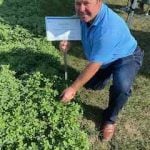During the next six weeks, Allan Groeneveld plans to continue his search for about 1,700 round bales of hay for his cattle.
If he finds reasonably priced hay, he’ll keep most of his 300 cows. If he can’t, he’ll sell most of his herd.
“It has to pencil out,” said Groeneveld, who raises cattle near Pigeon Lake, Alta.
Down the road at Tomahawk it’s a similar story. Tracy Wirstiuk and his neighbour sold an extra 150 cows this fall, when they normally would have kept those cattle in the herd.
Read Also

Agriculture ministers commit to enhancing competitiveness
Canadian ag ministers said they want to ensure farmers, ranchers and processors are competitive through ongoing regulatory reform and business risk management programs that work.
“It’s not that you can’t find feed, you can’t find it for a reasonable price,” said Wirstiuk.
He has noticed the price of feed slowly creeping down from the high prices of July.
In the meantime, he’s priced pellets, straw and screenings.
If he can buy his feed for less than four cents a pound, he’ll keep the cattle. If not, they will be sold. He refuses to go deep in debt for cattle feed.
Barry Yaremcio, beef and forage specialist with Alberta Agriculture, said the memory of buying expensive feed during the drought of 2002, only to see cattle prices crash the following year, are clear in producers’ minds.
“The guys say they learned their lesson in 2002 and it took too long to dig themselves out of a hole,” said Yaremcio.
Farmers are looking at creative feed solutions to find less expensive alternatives to hay. Some are looking at their available feed, calculating the amount cows will consume and waste and working out the math to see how many cattle they can keep.
Others are looking at dry distillers grain or other feed byproducts to reduce the cost. Some are checking out pellets, straw, grain or even two-year-old hay.
Most feed shoppers have a budget they refuse to exceed.
Earlier in the year, the forage situation looked worse, said Yaremcio. Canola crops that didn’t make grade were turned into silage and grain crops that were cut for green feed have had regrowth, allowing cattle to graze fields. Two large swaths of hail that went through central Alberta turned hundreds of acres of grain into forage.
Rain in early August in parts of Alberta gave pastures a boost.
The combination of new grazing alternatives allowed farmers to delay digging into hay supplies.
“Knocking off 60 days of feeding helps,” Yaremcio said.
Other producers took advantage of the federal tax deferral program that allowed them to sell their cattle and defer paying taxes on that income for two years. Few believe the cattle will return to the farm.
In a recent Statistics Canada report, Canadian cattle inventories were down 2.3 percent as of July 1 to 14.84 million head.
Andre Bonneau, forage management specialist with Saskatchewan Agriculture, said cattle producers worried about feed shortages have spent most of the summer trying to make alternative plans.
Some have put up green feed and others have sold cattle.
On the provincial government’s forage and feed listing website, there is a long list of hay for sale and hay wanted ads, but they’re not in the same area of the province.
“One of the biggest issues is transportation. You can find some fairly cheap feed, but to get it to where it’s needed is quite expensive,” said Bonneau.
He hears talk of people moving cattle from Alberta to Saskatchewan or within Saskatchewan, but he hasn’t seen it happen yet.
“There are pockets in the province with extra feed, but it’s not on the west side where it’s needed.”














